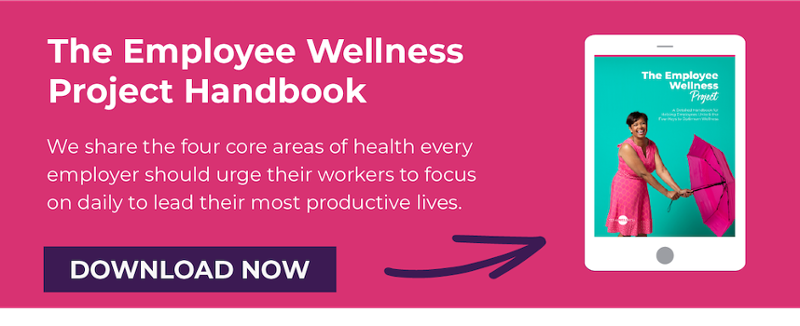 Happiness at work is not a myth.
Happiness at work is not a myth.
Your employees really can be happy, healthy, and fulfilled in their professional lives.
While you may not need to hire a Chief Happiness Officer – yes, that’s an actual job — you can make tweaks to boost workplace happiness. Not only is a happy workplace a nicer atmosphere for everyone who enters, but it also makes productivity levels shoot through the roof.
A study from The University of Warwick found joyful professionals are up to 12% more productive than unhappy workers. More importantly, being happy at work is also tied to overall better well-being and health.
Interested in keeping your workers happy?
Here’s a look at five ways to create more joy and real smiles in your workplace this year.
The Benefits of Happy Workplaces
Psychology Today defined happiness as “more than simply a positive mood.” It’s actually “a state of well-being that encompasses living a good life, one with a sense of meaning and deep contentment.”
Workers who feel a deep sense of contentment are generally more enthused to come to work in the morning. In turn, it makes it easier to show up and do the work instead of feeling like it’s a drag to get through “another workday.”
One study by iOpener Institute found employees who feel happy at work are 65% more energetic than employees who don’t. They also tend to stick with their jobs over a longer period of time, too.
Why are happy employees better employees? They generally are:
- More productive
- Better problem solvers
- Sick less often
- Equipped to deal with stress better
Additionally, happy workers are more committed to the company’s success and customer satisfaction.
The cost savings are apparent, too, when workers are content.
Workplace happiness lowers health care costs, reduces accidents, improves relationships between employees, reduces turnover, supports customer loyalty, and overall improves the company’s bottom line.
5 Ways to Increase Workplace Happiness
As a leader, when you look around your workplace, it’s much more inspiring to see smiling faces instead of stressed-out individuals.
When stress does pile up, more satisfied employees aren’t likely to throw in the towel ASAP.
Unfortunately, employee burnout is a real challenge in high-pressure work environments. Workplace burn-out is such a problem that even the World Health Organization (WHO) added it as an official condition in its International Classification of Diseases.
Yikes.
Not interested in seeing your employees burn the candle at both ends for too long?
Here’s a look at five tips to start implementing to improve your office spaces and culture for a productive 2020:
1. Create a Strong Company Culture
Your company culture is all about what you say, do, and work on every single day. It’s the “feel” of your office, so to speak. It’s how you treat one another, customers, and the community. The mission of your company is deeply entwined in your culture. By sticking to those mission words, you define your company culture.
Here’s how to keep your culture positive:
- Give them their “why” - Help your employees focus on “why” your products and/or services are important. While they should know the features, it’s more motivating to understand how it can change others’ lives.
- Share big-picture goals - Develop a clear vision and mission statement and share regularly. A quarterly update can be helpful.
- Showcase philanthropy - Share how your company contributes to society and/or charities. Encourage employees to get involved by donating their time or money to causes close to your company’s heart.
- Embrace individual gifts - Encourage creativity, humor, and diversity in daily activities.
2. Engage Employees
We all want to be heard. That’s especially the case of employees. If an unhappy employee thinks their opinion won’t count, they’ll remain silent and nothing will change. Engage workers to get a better understanding of what’s happening within the company that’s of concern, working well, etc.
Here’s how to do it:
- Ask and engage - Regularly request input, opinions, and reviews. Follow-up with individuals who are unhappy and happy. Ask for feedback on how the workplace culture is impacting them positively or negatively.
- Don’t micromanage - Employees who have more control over their schedules are happier. As long as the work gets done, see to it that they continue to have some flexibility in their days.
- Give praise - Acknowledge “a job well done” in email shout-outs, meetings, in-person, etc.
- Highlight roles - Give employees a purpose by highlighting the importance of their role in the company. An employee “Wall of Fame” is a great way to do this.
- Offer continuing education - Provide regular training and improvement opportunities to let workers know their work and knowledge is valued.
3. Encourage and Support Downtime
Employees need to disengage from work during breaks and downtime. Leadership that embraces this aspect of a workplace culture generally have an easier time getting employees to follow suit. Doing so allows for creativity and productivity to flourish upon returning to work tasks.
How to do it:
- Set up a relaxing break room - Breaks should be a time to physically — and mentally — break away from work. Create a break room your employees actually retreat to during breaks. Add a mini library, fresh fruits, healthy snacks, and comfy chairs to unwind in.
- Let them unplug - Consider a “no email” policy during off-hours and don’t allow work communication during vacations or weekends.
- Create outside areas to unwind - Nature is a great way to disconnect from work. Research shows our mood shifts when we spend time outdoors. Consider creating an outdoor garden or plant-filled courtyard that encourages no cell usage for employees to find their zen.
4. Help Employees Find Purpose Outside of Work
Employees need to have a healthy work-life balance in order to feel refreshed and relaxed. Balancing work and play enables time for creative thinking and problem-solving that can’t always be done during structured work time. All of a person’s purpose shouldn’t be focused on work.
Here’s how to encourage life activities outside of work:
- Set up outside meet-ups - Encourage employees to meet up outside of work for fun events like 5k runs, workout sessions, book clubs, cooking events, etc.
- Help them ignite their passions - Ask and encourage employees to find a passion outside of work and help them pursue it. Support employees with information about local activities. Bring in fliers for local events and classes and leave them in the break room.
- Allow for flexible schedules - See to it that your employees are happy with their schedules. For example, let them work at home one day a month to give them time to attend doctors’ appointments.
- Support volunteer work - Set up group volunteering days on weekends or once a quarter. Giving back together outside the office gives employees a chance to connect and bond in ways they can’t inside the office.
5. Promote Workplace Wellness
When your wellness committees make it a priority to focus on employee health on a regular basis, happiness automatically jumps. When you feel well, your mood improves and you have energy to do the things you love with enthusiasm — inside and outside of work.
To promote workplace wellness:
- Encourage nourishment - Provide healthy snacks and break areas that allow employees to bring their own healthy foods.
- Educate and promote health - Support healthy lifestyles with workshops and incentives.
- Offer proper physical support - Provide ergonomic workstations to help employees maintain healthy weights and body postures throughout the workday.
- Let them add a warm touch - Encourage personal items like photos, wall decor, and comforting items like salt lamps or diffusers.
- Create an inviting atmosphere - Consciously decorate spaces to make them more welcoming. Paint the walls relaxing colors, add wall art, and include air-purifying plants in common areas.
Workplace Happiness Matters to Your Employees
Happiness is contagious.
Most people love being around others who are positive and uplifting. If your entire team feels that way, they’ll be more energized and engaged to take on company projects — individually and as a team.
Not only does happiness matter to employees, but it should also matter to leadership as workplace happiness creates an overall more efficient and exciting workplace culture.
Workplace happiness makes for more productive employees, effective collaboration efforts, and an overall more enjoyable work environment. While happiness is certainly subjective, listening to your employees and watching their actions can show leadership where office morale boosters may be needed.
Feed the happiness wildfire as much as you can with the above office morale boosters. When you do, sit back and watch the workplace happiness fire spread.
How do you encourage workplace happiness? Share your thoughts on office morale boosters on social media using the hashtag #happinessatwork and tag us!



